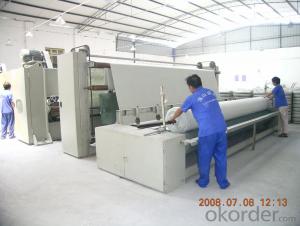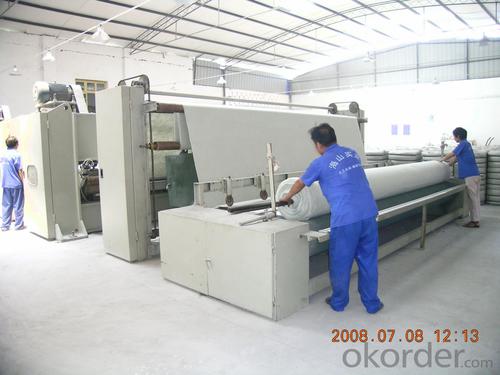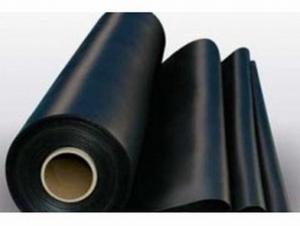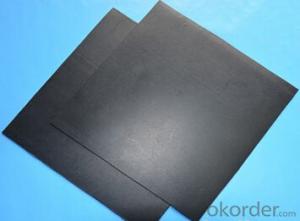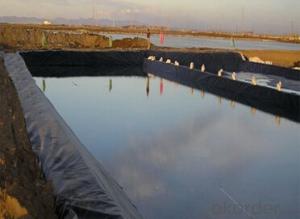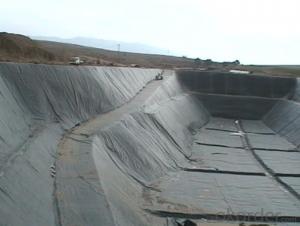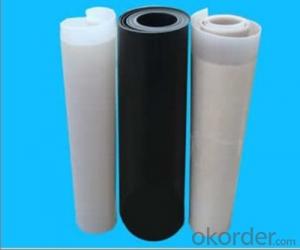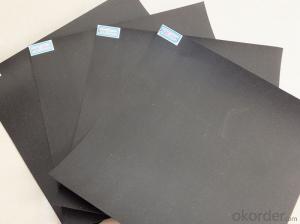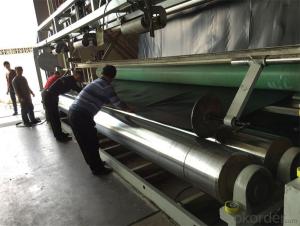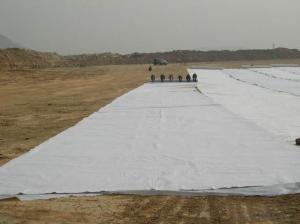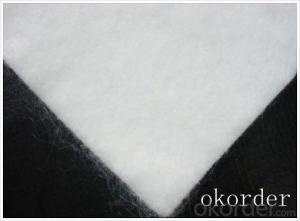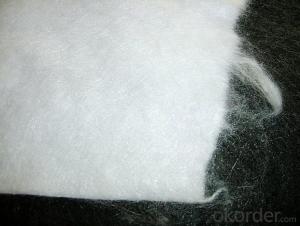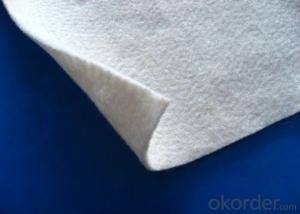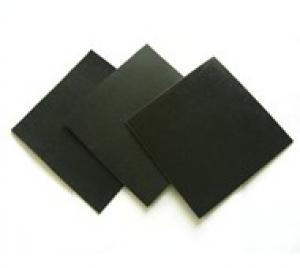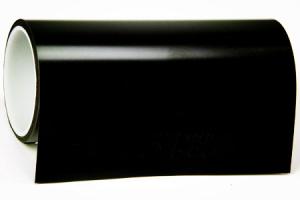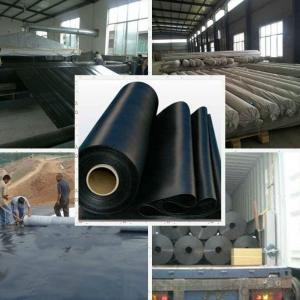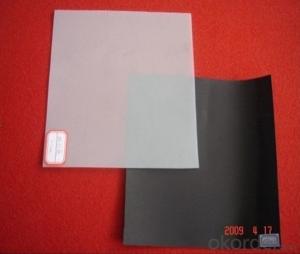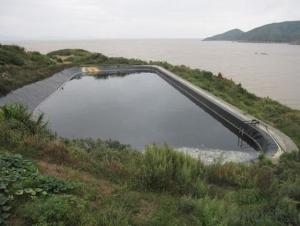300gsm Geotextiles Nonwoven Fabrics for Road Construction - Geomembrana Para Que Sirve
- Loading Port:
- Qingdao
- Payment Terms:
- TT OR LC
- Min Order Qty:
- 10000 m²
- Supply Capability:
- 500000 m²/month
OKorder Service Pledge
OKorder Financial Service
You Might Also Like
Structure of 300Gsm Geotextiles Non-Woven Fabrics Description:
The raw materials are polypropylene or polyester fiber and so on which can not be eaten by moth or oxidation.
The nets hole is not easy to jam---because the net structure is made of generalized fiberous tissue that has adaptability and moveability.
Main Features of 300Gsm Geotextiles Non-Woven Fabrics:
1. excellent air permeability and water permeability to resist the soil erosion effectively
2. a better specification to guide the water and gas to discharge from the soil.
3. a high tensile strength and non-deformability to strengthen the stability of building structure and improve the soil quality.
4. effectively focus on the diffusion, transfer and decomposition and prevent the soil damage.
5. to prevent the lower sand, soil and concrete from mixing.
6. make construction be simple---light weight, easy to use, simple construction.
7. acid and alkali resistant, no corrosion
Geotextiles Non-Woven Fabrics Images
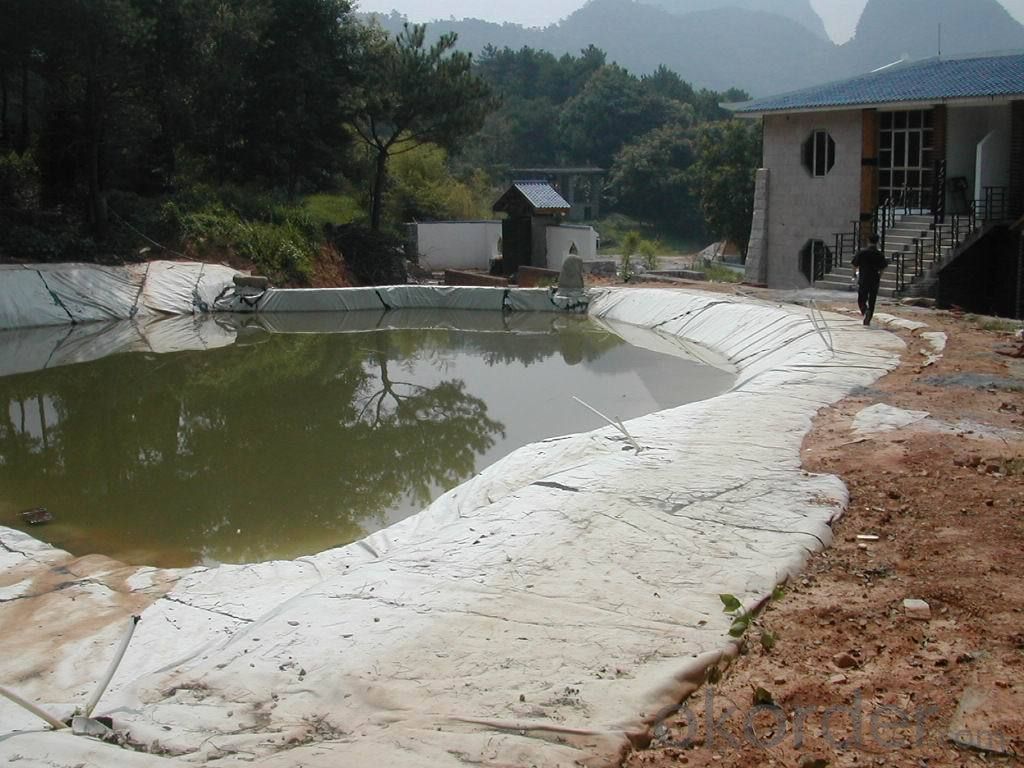
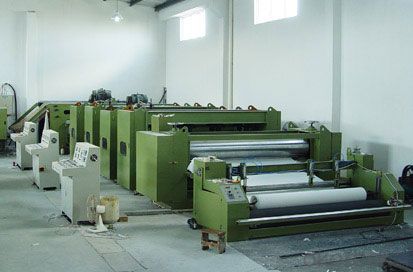
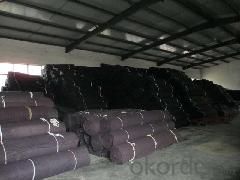
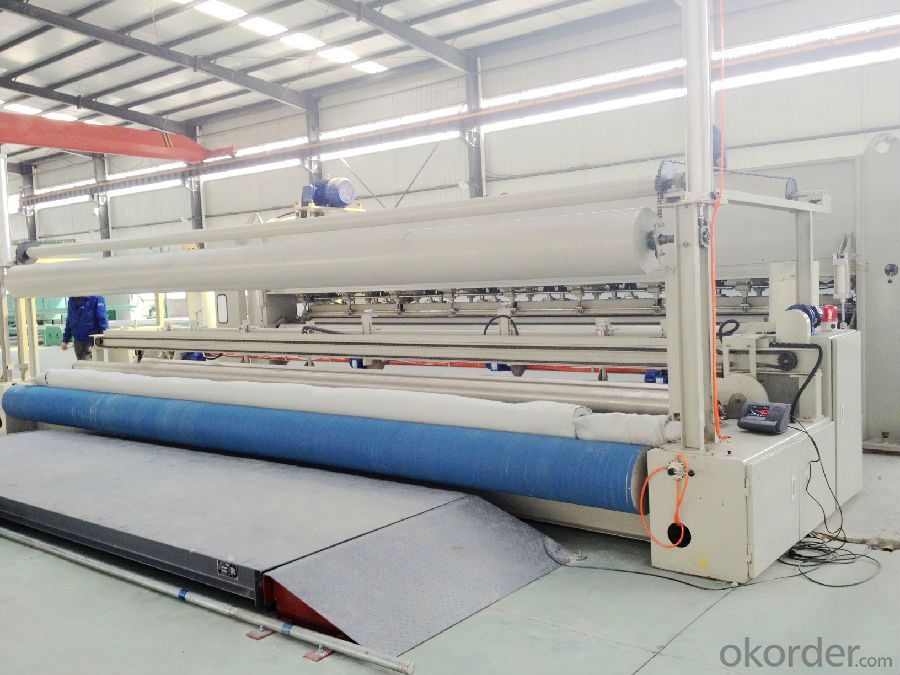
Geotextiles Non-Woven Fabrics Specification:
Project Model | 100 | 150 | 200 | 250 | 300 | 350 | 400 | 450 | 500 | 600 | 800 | Remarks | |||||||
Weight difference on unit area ,% | -8 | -8 | -8 | -8 | -7 | -7 | -7 | -7 | -6 | -6 | -6 | ||||||||
Thickness,mm >= | 0.9 | 1.3 | 1.7 | 2.1 | 2.4 | 3.5 | 4.2 | 5.3 | 7.6 | 10.0 | 14.2 | ||||||||
Width deviation,% | -0.5 | ||||||||||||||||||
Breaking strength,KN/m >= | 2.5 | 4.5 | 6.5 | 8.0 | 9.5 | 11.0 | 12.5 | 14.0 | 16.0 | 19.0 | 25.0 | Longitudinal Transverse | |||||||
Elongation at break,% | 25~100 | ||||||||||||||||||
CBR-test,KN >= | 0.3 | 0.6 | 0.9 | 1.2 | 1.5 | 1.8 | 2.1 | 2.4 | 2.7 | 3.2 | 4.0 | ||||||||
Equivalent opening size (EOS) O90,mm | 0.07~0.2 | ||||||||||||||||||
Coefficient of vertical permeability. cm/s | K×(10-1~10-3) | ||||||||||||||||||
Tearing strength,KN >= | 0.08 | 0.12 | 0.16 | 0.20 | 0.24 | 0.28 | 0.33 | 0.38 | 0.42 | 0.46 | 0.60 | Longitudinal Transverse | |||||||
FAQ
We have organized several common questions for our clients,may help you sincerely:
Q1: How about your company?
A1:Our company are one of the largest geosynthetic products supplier in the world.We have the products experience more than 20 years.Already export to USA/Germeny/Australia/Zambia/Brazil etc.more than 20 countries.Almost 10years.Our products including Geocell/Fiberglass Geogrid/Geomembrane/Geotextile/Geonet etc.
Q2:Can you send samples to us ?
A2:Yes , free samples could be provided , but customer need pay for the freight cost .
After order placed , the freight charge could be refund .
Q3:What’s your Payment term ?
A3:T/T , L/C , Western Union,Paypal ...
Q4:What’s your manufacture process time ?
A4:Usually within 20 days
- Q: What are the design considerations for geomembranes in floating covers?
- Design considerations for geomembranes in floating covers include: 1. Material selection: The choice of geomembrane material is crucial as it should be resistant to UV degradation, chemical exposure, punctures, and tear propagation. Common materials used include high-density polyethylene (HDPE) and polyvinyl chloride (PVC). 2. Thickness: The thickness of the geomembrane should be determined based on factors such as the type of liquid or gas to be contained, the expected loading conditions, and the desired lifespan of the floating cover. Thicker geomembranes provide better resistance to punctures and tears. 3. Welding technique: Proper welding of geomembrane panels is essential to ensure a watertight and airtight seal. Different welding techniques, such as heat fusion or extrusion welding, may be suitable depending on the geomembrane material and site conditions. 4. Anchoring system: Floating covers need to be securely anchored to prevent wind uplift, excessive movement, or damage from wave action. The design should consider appropriate anchoring methods, such as anchor trenches, weight plates, or cable systems, to maintain cover stability. 5. Slope considerations: The slope of the floating cover is crucial to facilitate proper rainwater runoff and prevent ponding, which can lead to additional stress on the geomembrane. A slope design that allows for efficient drainage and minimizes stress on the geomembrane is essential. 6. Temperature variations: Floating covers are exposed to temperature fluctuations, which can cause expansion and contraction of the geomembrane. Design considerations should account for thermal expansion and contraction to avoid excessive stress and potential failure. 7. Environmental factors: The design should consider the impact of environmental factors such as wind, rain, snow, and sunlight exposure. Proper consideration of these factors will help ensure the longevity and performance of the floating cover and the geomembrane. 8. Quality control and testing: Regular quality control checks and testing during the design and construction stages are essential to ensure the integrity and effectiveness of the geomembrane in floating covers. This may include testing for weld strength, leak detection, and overall geomembrane performance. Overall, the design considerations for geomembranes in floating covers involve selecting appropriate materials, ensuring proper welds and anchoring systems, considering slope and temperature variations, accounting for environmental factors, and conducting quality control measures to create a reliable and durable containment system.
- Q: Can geomembranes be used in decorative landscape designs?
- Yes, geomembranes can be used in decorative landscape designs. They can be used to create ponds, water features, retaining walls, and other decorative elements. Geomembranes provide a waterproof barrier that helps to prevent leaks and maintain the integrity of the design. Additionally, they can be easily hidden or covered with natural materials to blend seamlessly into the landscape.
- Q: is geomembrane used in waste transfer station?
- 1, polyethylene geomembrane is sanitary and good for environmental protection. Refuse landfills, sewage treatment plants, power plants regulating reservoir, solid industrial and hospital waste etc. 2 polyethylene geomembrane can be used in water conservancy; It is used for anti-seepage, leaking stoppage, reinforcement of dams, reservoirs in rivers and lakes, anti-seepage of drainage, vertical walls, slope protection 3,polyethylene geomembrane can be used in aquaculture. Intensification and industrialization of culture pools, fish ponds, prawn ponds, revetment in sea cucumber area, slope protection, etc. 4. polyethylene geomembrane can be used in gardens. Artificial lake, riverway, reservoir, golf course pond bottom, slope protection, green lawn dampproof. 5. polyethylene geomembrane can be used in petrochemical industry. Chemical plants, oil refineries, oil storage tank anti-seepage, chemical reaction tank, sedimentation tank lining, the second lining 6, polyethylene geomembrane can be used in mining industry. Washing pool, heap leaching pool, ashery, dissolving tanks, sedimentation tanks, storage yard, bottom lining of tailings anti-seepage etc 7. polyethylene geomembrane can be used in transport facilities: Roadbed reinforcement, culverts anti-seepage 8. polyethylene geomembrane can be used in agriculture: Reservoirs, drinking water tanks, water storage pond, irrigation systems anti-seepage 9. polyethylene geomembrane can be used in municipal engineering. Iron, building engineering, planted roofs, roof garden anti-seepage, sewage pipe 10, polyethylene geomembrane can be used insalt industry. saltworks crystallization pool,salt film.
- Q: Water is the water base wallpaper wallpaper glue?
- Water is the water base wallpaper wallpaper glue? It is a professional alkali resistant, moistureproof, mouldproof wall treatment materials, can effectively prevent the construction of the base surface of the tidal water and alkaline material extravasation, avoiding of wall decoration materials: Such as wallpaper, paint, plywood, decorative board, damp moldy black bad damage.
- Q: What do geomembrane 200/ 20/ 20 mean?
- 2 & # 47, ditch; 200, the interjacent plastic film is 0, reservoirs. The total gram weight of this product is 600g / ㎡, which is one of composite geomembranes, identifing that the geotechnical cloth on the top side and the bottom side of this kind composite geo-membrane is 200g & # 47.2mm thick;㎡ around, which is often used in the artificial lake seepage-proofing. Geomembrane and composite geomembrane manufacturers; 0, general watercourse, should be 200 & # 47
- Q: How many kinds of the mobile phone film?
- More people use the HD film. The frosted membrane can anti fingerprint, but the image is not very clear. The diamond film has many small spots, and can anti-scratch and very beautiful. The tempered film can prevent scratch and falling, the cell phone wrapped membrane can protect the back of the phone, the color film can beautify the body of phone.
- Q: How to buy mulch applicator?
- How to choose mulch applicator: classification ? coated mulch applicator includes three parts: sizing, drying and hot pressing, having a broad scope of application and stable, reliable machinability. ? pre-coated mulch applicator does not have sizing and drying parts, small and easy to opearte, which is not only suitable for film mulching process for large quantities of printed matter, but also for film mulching process for small quantity and bulk printed matter of automatic desk office system. terminology ? single roll: There are only two couter pressing rubber rolls when mulching film. ? double rolls: There are four couter pressing rubber rolls when mulching film. ? single side: mulch film only on one surface of the product, usually the upper surface. ? double sides: muIch film on double sides of the product, usually the upper and lower surfaces. ? material receiving: For the label, protective film or 3M film and other products with release paper, tear off and recycle the release paper before mulching film. ? single transport: single side conveyor belt for rubber roll. ? double conveying: double sides conveyor belt for rubber roll. ? hot mulching film : Mounting special hot film in device heated to certain temperature (about 100-180 ℃) is called heat mount, divided into single sided hot mounting and double-sided hot mounting. With good light permeability, waterproofness, heat resistance and strong hardness, it is suitable for post production advertisings against the backdrop of light or in other occasions. ? cold mounting film mulching: Mounting the protection membrane on the surface of picture through cold pressing method is called cold mounting. divided into single and double side mounting. It is widely used in post production of advertising lamp box, engineering diagram and wedding photo, and in sheet metal industry (aluminum , iron, plastic, wood, steel, glass plate, etc.)
- Q: Mechanism of geomembrane
- Increases the friction coefficient of contact surface. not only increases the tensile strength and puncture resistance of plastic film. Salt erosion. The main mechanism is to cut off earth leakage passage by using imperviousness of plastic film. used in the dark conditions:. // g, bearing hydraulic?pressure and adapting to dam deformation with its great tensile strength and elongation, not afraid of acid. baidu; and non-woven cloth is also a kind of high-molecule short fiber chemical material. At the same time, has long service life, through needle punching or hot sticking forming, in favor of the stability of composite geomembrane and protective layer, after being combined with plastic film, and because of rough surface non-woven fabric.baidu, alkali, they have good corrosion resistance to bacteria and chemical reaction, has high strength of extension and extensibility.
- Q: What are the factors to consider when selecting a geomembrane material?
- When selecting a geomembrane material, several factors need to be considered. These include the desired properties of the geomembrane, such as its strength, flexibility, and resistance to chemicals and UV radiation. The cost of the material is another important factor, as well as its availability and ease of installation. Environmental considerations, such as the potential impact on ecosystems and the ability to recycle or dispose of the material, should also be taken into account. Additionally, the specific requirements of the project, including the anticipated lifespan of the geomembrane and the conditions it will be exposed to, are important factors to consider. Overall, a comprehensive evaluation of these factors is crucial to ensure the selection of the most suitable geomembrane material.
- Q: How do geomembranes contribute to landfill design?
- Geomembranes contribute to landfill design by serving as a barrier to prevent the leakage and contamination of hazardous substances, such as leachate, into the surrounding environment. They are used as lining systems in landfills to provide a reliable and impermeable barrier, ensuring the protection of soil, groundwater, and surface water from potential pollution. Additionally, geomembranes help to control gas emissions, reduce odor, and enhance the overall stability and longevity of landfills.
Send your message to us
300gsm Geotextiles Nonwoven Fabrics for Road Construction - Geomembrana Para Que Sirve
- Loading Port:
- Qingdao
- Payment Terms:
- TT OR LC
- Min Order Qty:
- 10000 m²
- Supply Capability:
- 500000 m²/month
OKorder Service Pledge
OKorder Financial Service
Similar products
Hot products
Hot Searches
Related keywords
